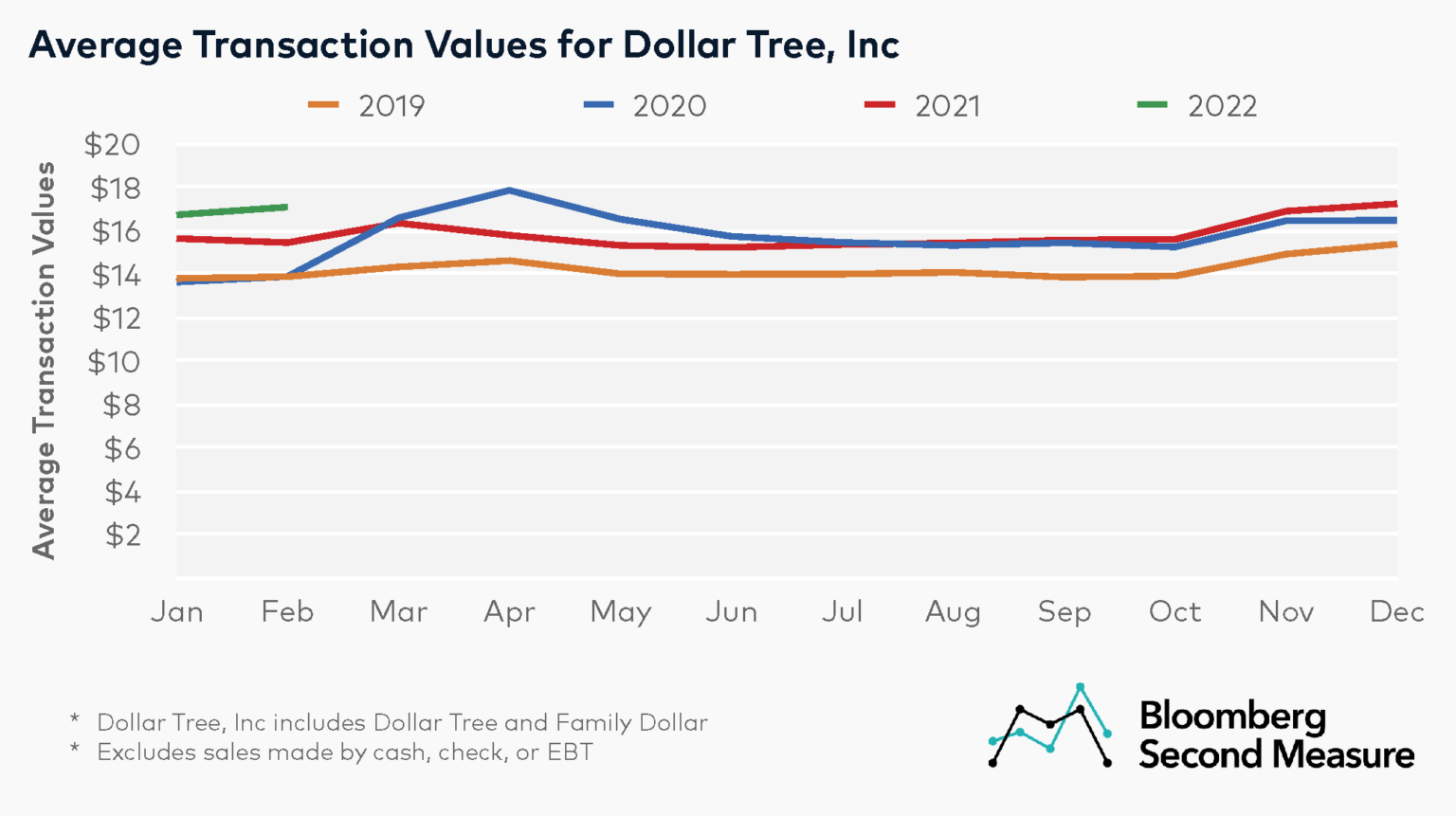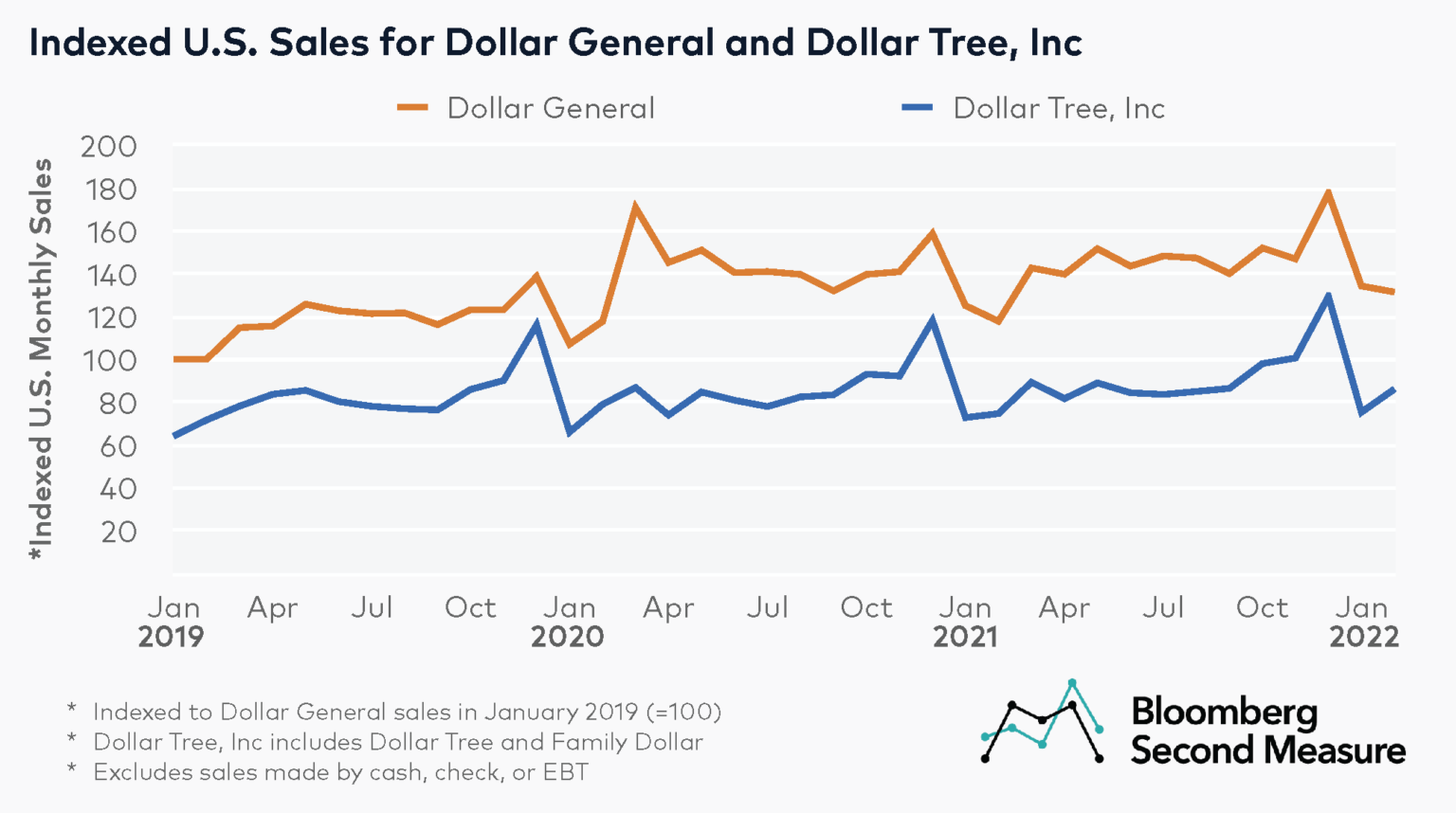
The era of the true “dollar store” is coming to an end. In late 2021, Dollar Tree announced that it would increase its main price point from $1 to $1.25, ending its pricing model of 35 years and joining other discount chains in providing low-cost—but not exclusively $1—items to customers. Consumer transaction data reveals that so far in 2022, average transaction values for Dollar Tree, Inc (NASDAQ: DLTR) have been elevated, continuing its trend of increasing transaction values during the pandemic. However, as Bloomberg Second Measure’s data shows, Dollar General (NYSE: DG) continues to have a larger dollar store market share compared to Dollar Tree, Inc, as Dollar General’s customers buy more frequently and spend more per visit.
Dollar Tree, Inc’s (NASDAQ: DLTR) average transaction values have risen in 2022
Dollar Tree, Inc is composed of its namesake Dollar Tree—known for its slogan “Everything $1”—as well as the higher-priced chain Family Dollar (which was acquired in 2015). In February 2022, 71 percent of Dollar Tree, Inc’s sales came from the Dollar Tree brand, while the remaining 29 percent came from Family Dollar.
Our data shows that average transaction values at Dollar Tree, Inc were elevated in the first few months of 2022, compared to the same months in previous years. In February 2022, Dollar Tree, Inc customers spent an average of roughly $17 per transaction, 11 percent higher than the year before and 23 percent higher than two years ago.

Average transaction values have generally grown at Dollar Tree, Inc during the pandemic. Between February and April of 2020, average transaction values grew 29 percent and have since remained higher than pre-pandemic levels. Aside from increased consumer spend due to stockpiling, one factor that might contribute to rising average transaction values over the past two years is the potential migration of some in-store cash, check, or EBT transactions (all of which Bloomberg Second Measure does not observe) to online credit card transactions during the COVID-19 pandemic.
Another noticeable trend is that Dollar Tree, Inc typically sees an uptick in average transaction values in November and December. Seasonal items, gifts, and party decor reportedly account for a significant share of Dollar Tree, Inc’s business, which may partially account for the higher transaction values observed at the end of the year. Other potential reasons for increasing spend at Dollar Tree may include the introduction of new price points. In addition to the Dollar Tree price increase to $1.25 in late 2021, Dollar Tree, Inc has been expanding its Dollar Tree Plus concept, which sells products at a range of price points up to $5. The company has also been opening more Dollar Tree/Family Dollar combo stores.
Dollar General (NYSE: DG) sales continue to outperform Dollar Tree, Inc’s, driven by higher consumer spending and more frequent visits
Dollar Tree, Inc’s main competitor is Dollar General, a national discount chain that primarily serves rural communities. Interestingly, Dollar Tree, Inc’s board of directors—recently revamped at the behest of activist investors—now includes a former chief executive of Dollar General.
Both Dollar General and Dollar Tree, Inc experienced sales growth during the pandemic, a trend that has continued into 2022. In February 2022, Dollar General’s sales were up 12 percent compared to the same month in 2021 and 2020. Dollar Tree, Inc’s sales in February 2022 were 15 percent higher year-over-year and 9 percent higher than in February 2020. These two dollar store companies also follow a similar seasonal sales pattern, in which sales spike each December before declining again in January.

Dollar General is the larger dollar store retailer by sales volume, accounting for 60 percent of dollar store market share between the two parent companies in February 2022. A few of the likely factors driving Dollar General’s higher dollar store market share are that Dollar General’s customers buy more frequently and spend more per visit than customers at Dollar Tree, Inc. In February 2022, Dollar General customers made an average of 2.7 transactions, compared to 1.8 transactions for customers at Dollar Tree, Inc. And while the average transaction value was about $17 that month for Dollar Tree, Inc, it was nearly $21 for Dollar General.
In recent months, Dollar General has reportedly seen strong sales growth for its frozen and refrigerated foods. The company’s DG Fresh initiative, which reduced product costs for frozen and refrigerated foods by bringing distribution in-house, has also opened the door for offering fresh produce in its stores, which may further increase consumer spend in the future.
Dollar stores are aiming for both retail and ecommerce growth
Like many other retailers, dollar store companies have been facing challenges related to supply-chain issues, inflationary pressures, and labor shortages in recent months. But that hasn’t stopped their plans for expansion. In its most recent fiscal year, Dollar General opened more than 1,000 new locations and plans to open another 1,110 new stores in the current year. Dollar General also launched Popshelf—a discount store aimed at wealthier shoppers in suburban areas—piloting 30 stores in six states in 2021. As part of its growth strategy, Dollar General plans to grow Popshelf’s retail footprint to 1,000 stores by 2025. Likewise, Dollar Tree, Inc opened 600 new stores in 2021 and plans to expand its higher-priced Dollar Tree Plus options and Dollar Tree/Family Dollar combo stores in 2022.
In addition to physical storefronts, these dollar store companies have also deepened their push into ecommerce over the past year as part of their growth strategy. Dollar Tree has partnered with Instacart and Dollar General with DoorDash for same-day home delivery of their products. Both businesses also offer delivery–though not same-day–through their own websites.
To learn more about the data behind this article and what Consumer Edge Research has to offer, visit www.consumer-edge.com.







Sign up to receive our stories in your inbox.
Data is changing the speed of business. Investors, Corporations, and Governments are buying new, differentiated data to gain visibility make better decisions. Don't fall behind. Let us help.













Sign up to receive our stories in your inbox.
Data is changing the speed of business. Investors, Corporations, and Governments are buying new, differentiated data to gain visibility make better decisions. Don't fall behind. Let us help.





